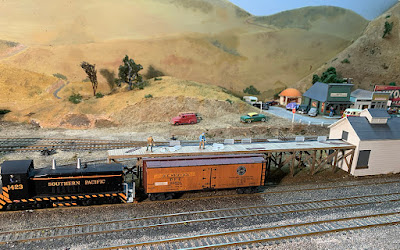A visitor to my layout recently asked about the ice deck I have modeled, and I explained a few aspects of it. It occurred to me that others might also be interested in the topic, thus this post.
Like nearly all layout owners, I have limited space for an ice deck. It’s rare, when visiting a layout, to see even a six-car deck (in HO scale, that’s already three feet long), though the prototype often had decks of 15 or 20 cars. Mainline ice decks in some cases were 110 cars long, the size of a reefer block on the SP and UP in ice reefer days.
My deck is just two cars long. Is this realistic? Absolutely. In Chapter 13 of the PFE book (Pacific Fruit Express, 2nd edition, Signature Press, 2000) are listed all the ice decks along PFE territory (SP, UP, and WP). There are a number of small ones, such as the two-car Modesto deck on the Tidewater Southern (a WP subsidiary).
That TS facility was owned by Union Ice Company, and was contracted with PFE for service. This kind of deck supplemented the much larger, nearby deck at Modesto on the SP, 29 cars long and capable of icing from both sides of the deck.
In building my small facility, I began with the idea that 300-pound ice blocks for icing reefers would most likely have to be shipped in. A small facility making consumer ice would rarely be able to produce such big blocks, and indeed, ice delivery was a common arrangement for small decks. Thus I only needed an ice storage building, not a giant ice manufacturing plant.
I built a simple structure using Evergreen shiplap siding, reinforcing the inside corners with Plastruct angles and the walls with square styrene tubing, as you see below. Outside corners were given scale 1 x 6-inch trim boards. I added five doors: a man door on each end, a pair of ice loading doors, and an ice delivery door for the ice deck, along with an office window.
In the photo below, with the removable roof off, you can see the construction, along with the two doors on the ice-deck end, and the ice loading door on the side, with its buffer timber underneath.
For the ice deck itself, I began with the PFE drawing in Chapter 13 of the PFE book. My ice deck would be a privately owned deck, so wouldn’t match the PFE standard (certainly no roof), but it gives dimensions and some idea about lumber sizes.
The drawing above is only a cross-section, and doesn’t show longitudinal bracing. For that, I relied on a photo of a small PFE deck at Spokane, Washington, which unlike the drawing above, didn’t have a center post (PFE photo, CSRM). It was an 8-car deck, and had PFE’s usual drop-down aprons, though those were uncommon on private decks.
With these considerations, I was able to build a deck from pre-stained stripwood, using a fixture to asemble each bent to ensure they were all the same. I added a stairway at the rear for workmen to access the deck. The door for delivery of reefer ice is on this side of the building.
Looking down on the deck, you can see the steel sliding tray used to slide ice blocks along the deck, from the ice house to where they are needed. Here an ice bridge is in use, to slide ice chunks (chopped from the original blocks) over to the further ice hatch. I included this photo. along with a discussion of the tools the men are using, in a recent blog post (see it at: https://modelingthesp.blogspot.com/2024/04/my-latest-column-in-mrh.html ).
Though my layout’s ice deck is small, it is realistic for the needs of the (fictitious) SP branch I model. I have tried to include prototypical details so this ice facility believably provides refrigeration for outbound reefer loads on my layout.
Tony Thompson









